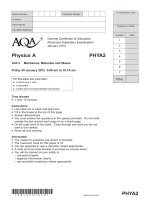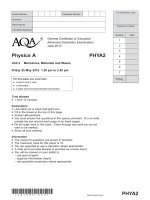AQA PHYA51 QP JUN14
Bạn đang xem bản rút gọn của tài liệu. Xem và tải ngay bản đầy đủ của tài liệu tại đây (461.7 KB, 12 trang )
Centre Number
For Examinerʼs Use
Candidate Number
Surname
Other Names
Examinerʼs Initials
Candidate Signature
Question
General Certificate of Education
Advanced Level Examination
June 2014
Mark
1
2
3
Physics A
PHYA5/1
5
Unit 5 Nuclear and Thermal Physics
Section A
Thursday 19 June 2014
4
TOTAL
9.00 am to 10.45 am
For this paper you must have:
l a calculator
l a ruler
l a question paper/answer book for Section B (enclosed).
Time allowed
l The total time for both sections of this paper is 1 hour 45 minutes.
You are advised to spend approximately 55 minutes on this section.
Instructions
l Use black ink or black ball-point pen.
l Fill in the boxes at the top of this page.
l Answer all questions.
l You must answer the questions in the spaces provided. Answers written
in margins or on blank pages will not be marked.
l Do all rough work in this book. Cross through any work you do not
want to be marked.
l Show all your working.
Information
l The marks for questions are shown in brackets.
l The maximum mark for this section is 40.
l You are expected to use a calculator where appropriate.
l A Data and Formulae Booklet is provided as a loose insert in Section B.
l You will be marked on your ability to:
– use good English
– organise information clearly
– use specialist vocabulary where appropriate.
(JUN14PHYA5101)
WMP/Jun14/PHYA5/1/E5
PHYA5/1
Do not write
outside the
box
2
Section A
The maximum mark for this section is 40.
You are advised to spend approximately 55 minutes on this section.
1 (a)
State what is meant by the binding energy of a nucleus.
[2 marks]
............................................................................................................................................
............................................................................................................................................
............................................................................................................................................
1 (b) (i)
235
When a 92 U nucleus absorbs a slow-moving neutron and undergoes fission one
112
122
possible pair of fission fragments is technetium 43 Tc and indium 49 In.
Complete the following equation to represent this fission process.
[1 mark]
n + 235
92 U →
1
0
112
43
Tc + 122
49 In + ..............
235
1 (b) (ii) Calculate the energy released, in MeV, when a single 92 U nucleus undergoes fission
in this way.
235
binding energy per nucleon of 92 U = 7.59 MeV
112
binding energy per nucleon of 43 Tc = 8.36 MeV
122
binding energy per nucleon of 49 In = 8.51 MeV
[3 marks]
energy released ..................................... MeV
(02)
WMP/Jun14/PHYA5/1
Do not write
outside the
box
3
235
1 (b) (iii) Calculate the loss of mass when a 92 U nucleus undergoes fission in this way.
[2 marks]
loss of mass ......................................... kg
1 (c) (i)
On Figure 1 sketch a graph of neutron number, N, against proton number, Z, for stable
nuclei.
[1 mark]
Figure 1
140
120
100
80
neutron number, N
60
40
20
0
0
20
40
60
80
proton number, Z
Turn over
(03)
ᮣ
WMP/Jun14/PHYA5/1
Do not write
outside the
box
4
1 (c) (ii) With reference to Figure 1, explain why fission fragments are unstable and explain
what type of radiation they are likely to emit initially.
[3 marks]
............................................................................................................................................
............................................................................................................................................
............................................................................................................................................
............................................................................................................................................
............................................................................................................................................
............................................................................................................................................
12
(04)
WMP/Jun14/PHYA5/1
Do not write
outside the
box
5
2
The carbon content of living trees includes a small proportion of carbon-14, which is a
radioactive isotope. After a tree dies, the proportion of carbon-14 in it decreases due
to radioactive decay.
2 (a) (i)
The half-life of carbon-14 is 5740 years.
Calculate the radioactive decay constant in yr –1 of carbon-14.
[1 mark]
decay constant ..................................... yr –1
2 (a) (ii) A piece of wood taken from an axe handle found on an archaeological site has 0.375
times as many carbon-14 atoms as an equal mass of living wood.
Calculate the age of the axe handle in years.
[3 marks]
age ......................................... yr
2 (b)
Suggest why the method of carbon dating is likely to be unreliable if a sample is:
[2 marks]
2 (b) (i)
less than 200 years old,
............................................................................................................................................
............................................................................................................................................
............................................................................................................................................
2 (b) (ii) more than 60 000 years old.
............................................................................................................................................
...........................................................................................................................................
............................................................................................................................................
6
Turn over
(05)
ᮣ
WMP/Jun14/PHYA5/1
Do not write
outside the
box
6
3 (a)
Define the Avogadro constant.
[1 mark]
............................................................................................................................................
............................................................................................................................................
............................................................................................................................................
3 (b) (i)
Calculate the mean kinetic energy of krypton atoms in a sample of gas at a
temperature of 22 ºC.
[1 mark]
mean kinetic energy ........................................... J
3 (b) (ii) Calculate the mean-square speed, (crms )2 , of krypton atoms in a sample of gas at a
temperature of 22 ºC.
State an appropriate unit for your answer.
mass of 1 mole of krypton = 0.084 kg
[3 marks]
mean-square speed..................................... unit ..........................
(06)
WMP/Jun14/PHYA5/1
Do not write
outside the
box
7
3 (c)
A sample of gas consists of a mixture of krypton and argon atoms.
The mass of a krypton atom is greater than that of an argon atom.
State and explain how the mean-square speed of krypton atoms in the gas compares
with that of the argon atoms at the same temperature.
[2 marks]
............................................................................................................................................
............................................................................................................................................
............................................................................................................................................
............................................................................................................................................
............................................................................................................................................
7
Turn over for the next question
Turn over
(07)
ᮣ
WMP/Jun14/PHYA5/1
Do not write
outside the
box
8
4 (a)
Define the specific latent heat of vaporisation of water.
[2 marks]
............................................................................................................................................
............................................................................................................................................
............................................................................................................................................
............................................................................................................................................
An insulated copper can of mass 20 g contains 50 g of water both at a temperature of
84 ºC. A block of copper of mass 47 g at a temperature of 990 ºC is lowered into the
water as shown in Figure 2. As a result, the temperature of the can and its contents
reaches 100 ºC and some of the water turns to steam.
4 (b)
specific heat capacity of copper = 390 J kg–1 K–1
specific heat capacity of water = 4200 J kg–1 K–1
specific latent heat of vaporisation of water = 2.3 × 106 J kg–1
Figure 2
47 g copper at 990 ºC
steam
20 g copper at 84 ºC
50 g water at 84 ºC
Before placement
(08)
After placement
WMP/Jun14/PHYA5/1
Do not write
outside the
box
9
4 (b) (i)
Calculate how much thermal energy is transferred from the copper block as it cools to
100 ºC.
Give your answer to an appropriate number of significant figures.
[2 marks]
thermal energy transferred ........................................... J
4 (b) (ii) Calculate how much of this thermal energy is available to make steam.
Assume no heat is lost to the surroundings.
[2 marks]
available thermal energy ........................................... J
4 (b) (iii) Calculate the maximum mass of steam that may be produced.
[1 mark]
mass ......................................... kg
Turn over
(09)
ᮣ
WMP/Jun14/PHYA5/1
7
Do not write
outside the
box
10
5 (a)
A nuclear reactor core is contained in a steel vessel surrounded by concrete.
State and explain the purpose of the concrete other than its structural function.
[2 marks]
............................................................................................................................................
............................................................................................................................................
............................................................................................................................................
............................................................................................................................................
5 (b)
A quantity of highly active waste removed from a nuclear reactor consists of similar
amounts of two radioisotopes, X and Y.
X has a half-life of about 20 days and emits γ rays and β– particles. Y has a half-life
of about 20 years and emits α particles. Assume that both X and Y become relatively
stable after their initial decays.
Discuss the problems of storing the waste until it is safe and describe and explain the
way in which the waste would normally be treated.
Your account should include details of:
l
l
a comparison of the storage problems associated with X and Y in both the short
term and the long term
how the waste is treated initially at the reactor site and how it could be stored safely
for a long time.
The quality of your written communication will be assessed in your answer.
[6 marks]
............................................................................................................................................
............................................................................................................................................
............................................................................................................................................
............................................................................................................................................
............................................................................................................................................
............................................................................................................................................
............................................................................................................................................
............................................................................................................................................
............................................................................................................................................
............................................................................................................................................
(10)
WMP/Jun14/PHYA5/1
Do not write
outside the
box
11
............................................................................................................................................
............................................................................................................................................
............................................................................................................................................
............................................................................................................................................
............................................................................................................................................
............................................................................................................................................
............................................................................................................................................
............................................................................................................................................
............................................................................................................................................
............................................................................................................................................
............................................................................................................................................
............................................................................................................................................
............................................................................................................................................
............................................................................................................................................
............................................................................................................................................
............................................................................................................................................
8
END OF SECTION A
(11)
WMP/Jun14/PHYA5/1
12
There are no questions printed on this page
DO NOT WRITE ON THIS PAGE
ANSWER IN THE SPACES PROVIDED
Copyright © 2014 AQA and its licensors. All rights reserved.
(12)
WMP/Jun14/PHYA5/1









